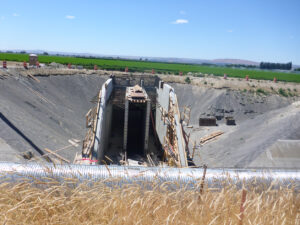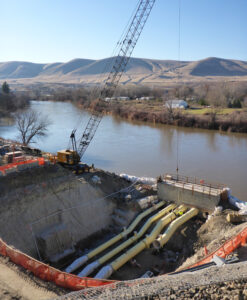RH2 Engineering, Inc., has been providing civil engineering, planning, and environmental services to municipal and irrigation clients across the Pacific Northwest for 40 years. RH2 can provide irrigation district clients with designs for full facility upgrades or evaluations of their assets that allow them to pinpoint crucial pieces of infrastructure to repair or replace. RH2’s efficiency-boosting designs include variable frequency drives and automatic controls.
In this interview, RH2 Project Manager Kyle Smith speaks with Irrigation Leader about his company’s services and the trends he sees today in the irrigation infrastructure world.
Irrigation Leader: Please tell us about your background and how you came to be in your current position.
Kyle Smith: I graduated from Seattle University in June 2008 and started at RH2 right out of college. I worked for 1 year in our Bothell office before transferring over to the Richland office, where I have been for over 10 years. I got my professional engineer license in 2012 and am currently a member of the American Society of Civil Engineers and the National Association of Corrosion Engineers. I’ve been fortunate to work on many great irrigation projects over the last 10 years, including Sunnyside Valley Irrigation District’s enclosed lateral improvements, Kennewick Irrigation District’s Red Mountain South Local Improvement District (LID), and South Columbia Basin Irrigation District’s Esquatzel pumping plant.
Irrigation Leader: Please tell us about RH2 and its history.

Kyle Smith: We’re a full-service engineering firm that specializes in municipal engineering. Founded in 1978, we focus on providing high-quality and high-value services to local government agencies throughout the Pacific Northwest. We provide water, sewer, and irrigation system design; hydraulic modeling; structural and electrical engineering; telemetry control systems engineering; and environmental and geotechnical services. We have seven offices in Washington and Oregon with 120 employees total, 100 of whom are professional engineers and scientists. We are currently working on irrigation projects in Washington, Oregon, and Northern California.
Irrigation Leader: RH2 works on both irrigation and municipal water projects. How do the two differ?
Kyle Smith: There are many differences between the two, including requirements for water treatment, construction seasons, and urban vs. rural construction. Another big difference is that in irrigation projects, we must deal with surface water and open-channel flow within canals and rivers. The variations in canal flow, irrigation demands, and water quality throughout the irrigation season can make designing pump stations and intake structures challenging. Typically, irrigation pump stations and pipelines are designed for larger volumes of water. Some of the pump stations that we design pump more than 100 cubic feet per second.
There’s always a focus on water and power conservation with irrigation as well. Canals can be lined or replaced with enclosed conduit systems, both measures that help conserve water. Pumps and controls can be replaced to help conserve power. A lot of the controls that help municipal water systems run efficiently are also included in our irrigation system designs.
Another big difference aside from engineering is the people. People in the irrigation industry are very much invested in their work. Many irrigation district board members are farmers who live in the district. Irrigation supports their livelihood and their communities. I really enjoy working with people who have so much passion and enthusiasm for what they do.
Irrigation Leader: Are RH2’s clients mainly irrigation districts?
Kyle Smith: RH2 has a diverse clientele of municipalities and districts. Most of our irrigation work is done in our eastern Washington offices. Probably one-third to one-half of my work is irrigation related; in some years, it may be up to 70 percent of my work. RH2 is currently working with all three Columbia basin irrigation districts, many of the irrigation districts in the Yakima River basin, and some smaller districts in Northern California.
Irrigation Leader: What are the main services you provide to your irrigation clients?
Kyle Smith: We offer full design and contract-administration services during construction for irrigation districts. Lately, we’ve been working on designing upgrades to electrical switchgears, motor controls, and pumps for irrigation districts in the Yakima and Columbia River basins. Much of their infrastructure was built in the 1940s by the Bureau of Reclamation. It’s held up well over the years, but there are electrical, mechanical, and structural components that are starting to wear out. Replacing these aging components gives us an opportunity to make pump stations more efficient. We can add variable frequency drives (VFDs), which can help pump stations react quickly to changing water demands. We can also design supervisory control and data acquisition (SCADA) and telemetry systems that can help districts monitor and operate their facilities remotely. These upgrades all help districts run more efficiently and contribute to water and power conservation.
When we’re designing these upgrades, we are mindful of costs and how they’ll affect the rates that end users pay. We want to make sure we’re planning carefully before upgrades begin and providing the best long-term solutions for our clients.

If an irrigation district is unable to do a full system or facility upgrade, we also can provide a conditional optimization reliability evaluation (CORE), which provides an accurate assessment of the condition of all the district’s critical assets. We can identify pump and motor issues that waste energy and reduce overhead costs by identifying preventative maintenance tasks that can be done to avoid equipment failure. We have different methods for doing this, including vibration testing on pumps, motor testing, power quality analysis, thermal imaging, and hydraulic modeling.
Another issue that’s been coming up recently is corrosion protection. This is something that a lot of districts don’t have in place and may be interested in. It can be a challenge to get our clients to understand the importance of corrosion protection, especially cathodic protection, as it hasn’t always been standard in the industry. However, once you start explaining that for a relatively low cost you can extend the life of a metal pipeline by 25 years or more, clients start getting more interested in the technology.
Corrosion protection starts with picking the right coating and lining for your application. This is typically your first layer of defense, especially for steel and ductile pipelines. However, there are always inherent imperfections in coatings and linings that can be caused by improper surface preparation, improper coating procedures, and damage during transport or installation. The second layer of defense is cathodic protection, which helps protect the pipeline from these imperfections. For an irrigation district, this typically involves a passive system with a sacrificial anode bed. The anode bed sacrifices electrons, which migrate to the steel or ductile iron pipeline. Chemical reactions around the pipeline create a barrier, protecting it from further corrosion. It’s an interesting process. Cathodic protection is standard in the oil and gas industry and required by the Reclamation on some projects. It’s something irrigation districts need to be thinking about, because it can double the lifespan of a pipeline.
Irrigation Leader: Would you tell us about one or two of your recent projects?
Kyle Smith: We’re currently working with Roza Irrigation District on pump station upgrades, as it’s time for it to start replacing some of its pumps that were built in the 1940s. We started the project by doing a CORE analysis of the efficiency of its existing pumps and electrical components. Then we looked at the replacement costs with in-kind volute pumps or vertical turbine pumps. We also evaluated the long-term costs and efficiencies of adding VFDs to the pump stations. We’re now starting to design upgrades for two pump stations based on the results of our assessment. Hopefully, these pump stations will be the templates for the other pump stations in their system.
We also just finished designing a cathodic protection system for East Columbia Basin Irrigation District’s EL 47.5 pipeline. The pipeline has approximately 2,800 linear feet of 54-inch-diameter steel pipe, which transitions to 42-inch-diameter PVC pipe with ductile iron fittings as it extends from the pump station. We helped the district design a cathodic protection system for the steel
pipeline, ductile fittings, and appurtenances, in accordance with Reclamation standards. The passive cathodic protection system includes sacrificial anode beds, joint bonding, isolation joints, and test stations. These systems are easy to install, and we can teach district staff how to install them with just a few days of training.
Irrigation Leader: Do you work with other federal or state agencies in addition to Reclamation?
Kyle Smith: Since we are typically working with surface water, we usually coordinate with state ecology departments as well as fish and wildlife departments. Depending on funding, we sometimes work with the U.S. Environmental Protection Agency, the National Resources Conservation Service, and the National Marine Fisheries Service. Pipelines usually include coordination with local agencies and state transportation departments. The permitting process for building a new facility or renovating an old facility can include coordination with the state historic preservation office and local tribes.
Irrigation Leader: What other new technologies do you expect to see expanding in the next 5 years or so?

Improvement District.
Kyle Smith: I see a lot of wireless communication technologies coming into the industry right now. For Kennewick Irrigation District’s Red Mountain South LID project, we evaluated several wireless technologies and ended up selecting a solar-powered, all-in-one radio monitoring system for its deliveries. Cellular modems are also becoming less expensive to operate and really help in remote areas where radios struggle. I think the real-time monitoring of irrigation systems is really going to help districts operate more efficiently.
Irrigation Leader: Does RH2 install SCADA systems as well as the pipelines?
Kyle Smith: We don’t install pipelines, but we do provide design services as well as onsite observation and contract administration during construction. We also design, integrate, program, and support SCADA systems for our clients. RH2 recently formed a new limited liability corporation, Control Systems Northwest, which allows us to perform installations of programmable logic controllers and other controls in Oregon; similar capabilities are coming soon to Washington and California.
Irrigation Leader: What is your vision for the future?
Kyle Smith: I see the irrigation industry adopting a lot of the technologies that are currently implemented in the municipal water world. We will start seeing less open-channel flow and more pressurized systems. Some irrigation districts will also have to change the way they operate as urban sprawl continues and they start serving residential customers. I see irrigation districts looking a lot more like municipal water districts in the future.
Kyle Smith, P.E., is a project manager at RH2 Engineering. He can be contacted at ksmith@rh2.com.
